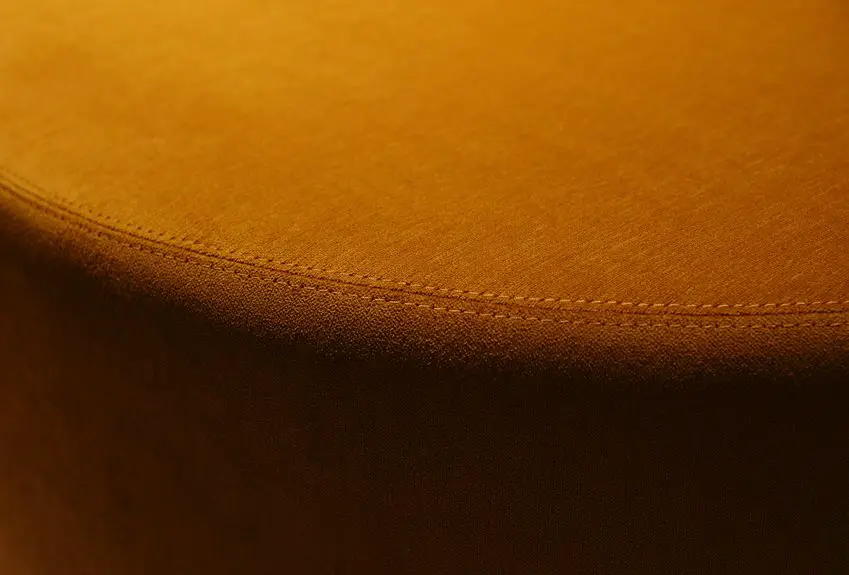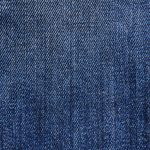Double rubs measure how many times fabric can withstand back-and-forth rubbing before showing wear, helping you gauge upholstery durability. A higher double rub count means the fabric resists abrasion better, making it ideal for heavy use, while lower counts suit lighter, decorative purposes. Testing follows industry methods like Wyzenbeek or Martindale, giving you reliable durability info. Understanding these details lets you pick fabrics that match your lifestyle needs, with plenty more factors affecting longevity you’ll want to explore.
Table of Contents
Key Takeaways
- Double rubs measure fabric durability by counting back-and-forth rubs until visible wear, indicating abrasion resistance.
- Higher double rub counts mean stronger fabrics suited for heavy use; lower counts fit decorative or low-traffic items.
- Common testing standards include Wyzenbeek (back-and-forth) and Martindale (circular motion) methods.
- Residential fabrics typically range from 15,000 to 25,000 double rubs; commercial fabrics exceed 30,000 for heavy use.
- Double rubs assess abrasion resistance only and do not reflect stain resistance, colorfastness, or comfort.
Understanding the Concept of Double Rubs
Double rubs measure how many times a fabric can withstand the back-and-forth rubbing motion before showing wear. When you choose upholstery, double rubs help you gauge its durability.
Higher double rub counts mean the fabric can handle more friction, making it ideal for busy areas like family rooms or commercial spaces. If your furniture sees frequent use, you’ll want a fabric with a higher double rub rating to avoid premature wear.
Conversely, for decorative pieces or low-traffic spaces, fabrics with lower counts might suffice. Understanding double rubs helps you match fabric durability to your lifestyle, ensuring your upholstery stays attractive longer.
Keep in mind, though, double rubs focus solely on abrasion resistance—not on other factors like stain resistance or colorfastness.
How Double Rubs Are Measured
You’ll want to know how double rubs are tested to understand fabric durability better.
The process involves a machine repeatedly rubbing the fabric until it shows wear, following strict industry standards.
This method guarantees you get reliable information about how long your upholstery will last.
Testing Process Overview
To understand fabric durability, manufacturers perform a specific test that measures how many times a piece of upholstery can withstand rubbing before showing wear.
In this process, a machine repeatedly rubs a small section of fabric with a standardized abrasive pad or brush. Each back-and-forth motion counts as a “double rub.”
You’ll find that the test continues until the fabric shows noticeable wear, like threads breaking or color fading. This number reflects the fabric’s durability level.
You can picture it as a controlled way to simulate years of daily use in just a few hours. By knowing this, you get a clear idea of how well your upholstery might hold up over time without guessing or relying on guesswork alone.
Industry Standards Explained
Several organizations set the standards that define how fabric durability is measured through double rubs.
When you look at upholstery fabric ratings, you’ll often see numbers based on tests by groups like the Wyzenbeek and Martindale methods. These tests simulate real-life wear by rubbing the fabric back and forth thousands of times.
The Wyzenbeek method counts double rubs until the fabric shows noticeable wear or thread loss, while Martindale measures abrasion resistance in cycles.
You’ll find that commercial fabrics typically require at least 15,000 double rubs, and residential ones have lower thresholds.
Understanding these standards helps you choose fabrics that match your usage needs, ensuring your upholstery lasts as long as you expect without premature damage.
The Martindale vs. Wyzenbeek Testing Methods
You’ll notice that Martindale and Wyzenbeek test fabric durability in different ways, using distinct procedures and measurement units.
Depending on where you are, one method might be more common than the other.
Understanding these differences helps you choose the right fabric for your specific needs.
Testing Procedure Differences
Although both the Martindale and Wyzenbeek tests measure fabric durability through double rubs, they use different procedures that can affect the results you see.
The Martindale test rubs fabric samples in a circular motion using abrasive wool, simulating wear from multiple directions. On the other hand, the Wyzenbeek test moves a cotton duck fabric back and forth over the sample in a straight line, mimicking repetitive rubbing in one direction.
These method differences mean Martindale often stresses fabrics differently than Wyzenbeek, which can impact how durability ratings translate to real-world use.
Understanding these procedural distinctions helps you interpret double rub numbers more accurately when choosing upholstery fabric for your specific needs.
Durability Measurement Units
Understanding how fabric durability is measured requires knowing the units each test uses to report double rub counts.
The Martindale method measures durability by counting the number of rubs until fabric shows noticeable wear, with one rub representing a single back-and-forth motion. Results are typically expressed in thousands of rubs, such as 20,000 Martindale rubs.
On the other hand, the Wyzenbeek test counts double rubs, where one double rub equals one complete back-and-forth cycle. Its results are also presented in thousands, like 15,000 double rubs.
While both units quantify abrasion resistance, their testing motions differ. Knowing these units helps you compare fabric durability accurately and choose upholstery that meets your needs without confusion between Martindale’s single rubs and Wyzenbeek’s double rubs.
Regional Usage Preferences
Different regions tend to favor either the Martindale or Wyzenbeek testing methods based on local industry standards and historical practices.
If you’re in Europe, you’ll notice the Martindale test is more common. It measures abrasion by rubbing fabric in a circular motion, which suits European upholstery styles.
In contrast, the U.S. and Canada lean toward the Wyzenbeek method, which moves fabric back and forth over a screen, reflecting North American preferences for durability testing.
Knowing these regional preferences helps you interpret fabric durability numbers correctly.
When shopping internationally, check which test was used to avoid confusion about a fabric’s true wear resistance.
Understanding this will empower you to make smarter choices for upholstery that lasts in your specific market.
What Different Double Rub Counts Indicate
You can gauge a fabric’s durability by its double rub count, which measures how many times the material can withstand rubbing before showing wear.
Lower counts, like under 5,000 double rubs, suggest the fabric suits light use, such as decorative pillows.
Counts between 5,000 and 15,000 indicate moderate durability, fitting for occasional use in homes.
When you see counts from 15,000 to 30,000, the fabric is robust enough for regular use in residential settings.
Anything above 30,000 double rubs means the fabric is highly durable, ideal for commercial spaces or heavy daily use.
Recommended Double Rub Levels for Various Uses
Although every space has unique needs, matching the double rub count to your usage guarantees your upholstery holds up well over time.
For light-use areas like guest rooms or decorative chairs, aim for fabrics with 10,000 to 15,000 double rubs. These handle occasional use without wearing out quickly.
In everyday family rooms or living spaces, choose fabrics rated between 15,000 and 30,000 double rubs to withstand regular sitting and movement.
High-traffic areas, such as sofas or commercial settings, demand durability with 30,000 double rubs or more.
If you expect heavy use or have pets and kids, look for fabrics exceeding 50,000 double rubs to assure long-lasting performance.
Factors That Affect Fabric Durability Beyond Double Rubs
While choosing the right double rub level sets a strong foundation for durability, other factors also influence how well your upholstery fabric performs over time.
The type of fiber—natural like cotton or synthetic like polyester—affects resistance to wear and stains. Fabric construction matters too; tightly woven fabrics tend to last longer than loose weaves.
Natural fibers like cotton and synthetic ones such as polyester differ in wear resistance; tighter weaves usually last longer.
Finishes and treatments, such as stain repellents or UV protection, can enhance longevity. How you care for your upholstery also plays a role—regular cleaning and avoiding harsh chemicals help maintain fabric integrity.
Finally, environmental conditions like sunlight exposure and humidity impact durability.
How to Interpret Double Rub Ratings When Shopping
Understanding double rub ratings helps you make informed decisions when selecting upholstery fabric.
When shopping, look for the double rub number on the fabric label or product description. This number indicates how many times the fabric can withstand rubbing before showing wear. Higher numbers mean greater durability.
For example, residential fabrics usually have 15,000 to 25,000 double rubs, while commercial-grade fabrics can exceed 50,000. Match the rating to your intended use—choose higher ratings for heavy-use areas like family rooms or offices.
Keep in mind, double rub ratings don’t reflect other factors like stain resistance or colorfastness, so consider those too.
Common Misconceptions About Double Rubs
Even if you pay close attention to double rub ratings, you might still fall for some common misconceptions about what they really mean. For example, a higher double rub count doesn’t always guarantee better comfort or stain resistance. It strictly measures abrasion durability, not overall fabric quality. Also, double rubs don’t predict how a fabric handles pilling or fading. Here’s a quick look at some misunderstandings:
| Misconception | Reality | What It Means For You |
|---|---|---|
| Higher double rub = softer | Double rubs measure durability, not feel | Check fabric material for comfort |
| All fabrics with 15,000+ double rubs are commercial grade | Some are borderline residential | Verify manufacturer’s usage advice |
| Double rubs test stain resistance | It only tests abrasion resistance | Consider additional fabric treatments |
| Double rubs measure colorfastness | No, they don’t | Look for UV and washfastness ratings |
| Low double rub count = poor durability | Depends on fabric type and use | Match fabric to your usage needs |
Tips for Extending the Life of Upholstery Fabric
To keep your upholstery fabric looking great for years, you’ll want to follow a few essential care tips.
First, regularly vacuum your furniture using an upholstery attachment to remove dust and dirt that can wear down fibers.
Rotate cushions frequently to guarantee even wear and prevent sagging.
Avoid placing your furniture in direct sunlight, as UV rays can fade and weaken fabric over time.
Address spills immediately by blotting with a clean cloth—never rub, which can damage fibers.
Use fabric protectors or stain guards designed for upholstery to create a barrier against stains.
Finally, follow manufacturer cleaning instructions carefully and consider professional cleaning periodically to maintain fabric strength and appearance.
These simple steps will help you get the most out of your upholstery’s durability.
Frequently Asked Questions
Can Double Rubs Indicate Stain Resistance of Upholstery Fabric?
You might think double rubs scream stain resistance, but they don’t! They measure fabric toughness, not spills. So, don’t bet your snacks on them; stain resistance depends on coatings and treatments, not just double rubs.
Do Double Rub Counts Affect Fabric Colorfastness?
Double rub counts don’t directly affect fabric colorfastness. You’ll want to check specific colorfastness ratings for fading or bleeding. Double rubs mainly measure abrasion resistance, so they focus on durability, not color retention.
Are Double Rub Tests Applicable to Outdoor Fabrics?
You’d think outdoor fabrics are tougher than steel, right? Double rub tests do apply but focus more on abrasion resistance indoors. For outdoors, UV exposure and water resistance matter just as much, so don’t rely solely on double rubs.
How Do Double Rubs Relate to Fabric Breathability?
Double rubs measure fabric durability, not breathability. You’ll want to check other factors like fiber type and weave for airflow. So, don’t confuse high double rub counts with how breathable a fabric feels.
Can Double Rub Ratings Predict Fabric Comfort Levels?
Ever wonder if fabric toughness hints at how cozy it feels? Double rub ratings measure durability, not comfort, so you can’t rely on them alone. You’ll want to take into account softness, breathability, and texture for true comfort.
- The Use of Nonwovens in Construction and Civil Engineering - July 11, 2025
- The Use of Nonwovens in Construction and Civil Engineering - July 11, 2025
- The Use of Nonwovens in Construction and Civil Engineering - July 11, 2025






